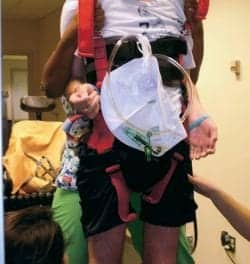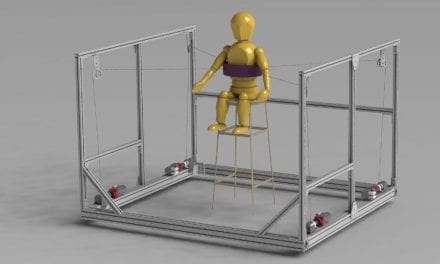 |
| Standing has many physiological as well as psychological benefits, including enabling eye-toeye communication, which increases self-confidence and overall self-image. |
When Medicare patients need standing systems, they look for alternative financing because the massive health plan for seniors does not pick up the tab—yet. Officials at the Virginia-based Rehabilitation Engineering and Assistive Technology Society of North America (RESNA) are putting final touches on a document that could change minds and open federal coffers. Destined for Capitol Hill, the paper makes a convincing case that standing systems provide considerable physiological benefits to patients with a wide range of disabilities.
As chairperson of the RESNA subcommittee that authored the 17-page document, Amy Meyer, PT, ATP, believes that many public and private payors—with the notable exception of CMS—are finally starting to understand the physical benefits of standing. In her role as pediatric and standing product specialist for Lebanon, Tenn-based Permobil, Meyer often takes on the part of advocate and battles what she calls CMS’ exclusionary policies.
CMS’ current standing frames/standing systems coverage policy states that the equipment is not primarily medical in nature, and thus not covered under Medicare. RESNA hopes to obliterate this notion and show CMS that standing is indeed clinically valuable, medically necessary for some clients, and should be covered in appropriate cases.
Many private entities, and Medicaids, already reimburse for standing units, but if CMS can be cracked, the remaining holdouts will likely disappear. Private payors that imitate Medicare’s rationale usually claim that the research for standing is not there, an argument that Meyer ardently disputes. “I assist with denial responses from private payors, some of whom say that standers are not covered because there is no research behind the benefits of standing, but that contention is completely false,” says Meyer. “There is a mound of research supporting standing. Unfortunately, private insurance can have exclusionary policies regardless of proof. In federally regulated programs, I can help the therapy team and providers to know the regulations, and how they can get this equipment funded. We have been successful in doing just that.”
In cases where patients and therapists refuse to accept Medicare’s judgment, some coverage decisions have actually gone to an administrative law judge and been approved under Medicare. If judges see the logic, could CMS be far behind? The key, says Meyer, is to keep the pressure on. “It’s important that we take every case that we feel strongly about to the edge of the appeals process, all the way to the hearing level if necessary,” Meyer says. “When it gets to a judge, it is usually a no-brainer at that point. I have had several cases actually dismissed even before the hearing took place because the judge reviewed the documentation, became convinced that the standing system was a medically necessary intervention, and ruled in favor of the client. We need to be empowered as rehab teams to fight for this equipment. Continuing to ask and show the need is the only thing that will bring about change.”
David Leckey, president of Levo USA, Brooklyn Park, Minn, says that therapists who believe it is too difficult to find funding need to realize that reimbursement often comes from unexpected places, and can vary from state to state. “Standing wheelchairs are funded from such diverse sources as workers’ compensation insurance, auto insurance, state worker retraining/back to work programs, state Medicaid, state health programs, and trust funds,” says Leckey. “Working with a dealer/provider and developing thorough medical justification documentation are key for giving clients the best opportunity to win the life-changing technology of standing wheelchairs.”
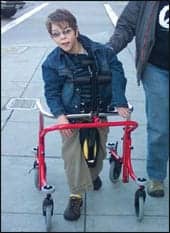 |
| Youngster walks with a gait trainer. |
Sellers of durable medical equipment (DME), who work with therapists to provide standing systems under the banner of “complex rehab,” know all about Medicare’s many hurdles. Complex rehabilitation remains under the threat of a competitive bidding program that most DME providers and industry advocates oppose. Competitive bidding opponents say the highly individualized nature of standing systems, frames, and power wheelchairs makes the product category a bad fit for the proposed program.
According to Nancy Perlich, COTA, ATP, therapists used miscellaneous codes until 2004 when the four main HCPCS codes came out (EO637-sit to stand; EO638-standing frame [one position]; EO641-multi-positional standing frame [prone, supine, or upright]; and EO642-standing frame mobile or dynamic]). “Medicare covered standing systems for about a year in 2004, but the allowable on the EO638 was so low that it was causing huge access issues, especially out west,” says Perlich, a reimbursement specialist/product development liaison for Altimate Medical, Morton, Minn. “The EO637 code was not much better and Medicare also pulled it. However, there is always room for these things to be revisited.”
As part of the National Coalition for Assistive and Rehab Technology (NCART) group that helped to submit the original HCPCS coding review, Perlich can attest to the variation among standing systems. The fact is that the appropriateness of any device depends on the diagnosis and prescription. “I don’t think any manufacturer will tell you that their equipment will work for everyone,” says Perlich. “There is so much variety out there—sit to stand, supine, upright, multipositional, mobile—there are even devices experimenting with whole body vibration.”
Perlich says that most experts agree that younger patients typically have an easier time acquiring standing systems. There are kids as young as age 2 using standing frames, and adults 80 and older using them. Diagnoses, which include cerebral palsy, multiple sclerosis, spinal cord injury, and traumatic brain injury, are as varied as the age ranges. To accommodate the wide range of possible patients, Perlich says her company tends to build base units with few frills, instead preferring to add on positioning options as needed.
The highly customized nature of standing systems highlights the need for payors to view these devices as a separate entity in the complex rehab category. “Standing systems are definitely a part of complex rehab, and they should not be viewed in the same light as walkers or crutches,” says Perlich. “As far as reimbursement goes, generally speaking, standing devices continue to be covered just fine, as long as the documentation is there to support medical need—for private insurance and Medicaid.”
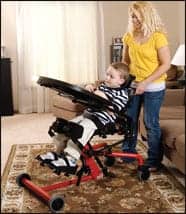 |
| A child enjoys the benefits of a standing system. |
Regardless of who ultimately pays, sitting in a wheelchair can literally be a pain in the neck for users who must constantly look up to address non-disabled people. The neck discomfort can eventually translate to psychological pain for patients who miss the feeling of height, reach, and eye-to-eye contact. “We can prove that the medical benefits are there,” says Jeff Wollmuth, sales manager, Stand Aid of Iowa, Sheldon, Iowa. “We take for granted every day that we can carry on a conversation looking at someone eye to eye, so those psychological benefits cannot be overlooked.”
While children don’t mind looking up at adults, their ability to move and explore is equally vital to cognitive development. Part of that exploration is aided by gait trainers, which could be deemed a cousin of standing systems. According to Larry Mulholland, president and founder of Mulholland Positioning Systems Inc, Burley, Idaho, research shows that static standing is not as effective as gait training when it comes to teaching children how to walk.
As is the case with standing systems in the elderly population, insurance coverage for children who use gait trainers also has its road blocks. “Some funders have inappropriately labeled these products as ‘toys,'” laments Mulholland. “They fail to connect the habitation issues with the medical costs of doing nothing. The budgets for rehabilitative equipment are separate from medical expense budgets, but there is a significant correlation that is not recognized.”
“With children, you want to encourage movement and self-initiated exploration,” adds Mary Wilson Boegel, president of Fresno, Calif-based Prime Engineering. “Particularly with children ages 5 to 7, it is kind of a use-it-or-lose-it scenario. Without proper gait trainers, a child’s cognitive and social development can be seriously hindered. With standing devices for adults, it is more about maintaining and improving physiology.”
As a 33-year industry veteran, Wilson Boegel started using the term “standing systems” many years ago to emphasize the modular nature and growing complexity of standing devices. “With the 22 models of standing devices that we have in our line, we refer to at least 15 of them as standing systems because they are highly functional positioning devices,” says Wilson Boegel. “Other equipment we would consider maintenance devices with less adjustability—referring to them as standers or standing cranes.”
Whether it’s a passive device or an integrated mobile device, Wilson Boegel points out that bodies respond to being in the upright position. Ultimately, the job of any standing system is helping to avoid the secondary medical concerns that are common in people with disabilities. “The idea is to help patients remain as healthy as possible and avoid secondary concerns that threaten life,” says Wilson Boegel. “If you survive your initial disability, the long-term side effects can easily become medical management issues if not cared for properly.”
Greg Thompson is a contributing writer for Rehab Management. For more information, go to www.rehabpub.com.
The Official Position
The official RESNA Position on the Application of Wheelchair Standing Devices could ultimately persuade Medicare to start covering standing systems. Meanwhile, the document includes bullet points that could serve as ammunition for coverage disputes down the road. As an antidote to constant sitting, the document points out that standing devices are often medically necessary because they enable certain individuals to:
- improve functional reach to enable participation in activities of daily living (ADLs), such as grooming, cooking, and reaching medication;
- enhance independence and productivity;
- maintain vital organ capacity;
- reduce the occurrence of urinary tract infections;
- maintain bone mineral density;
- improve circulation;
- improve passive range of motion;
- reduce abnormal muscle tone and spasticity;
- reduce the occurrence of pressure ulcers;
- reduce the occurrence of skeletal deformities; and
- enhance psychological well-being.
—GT
Products at a Glance
In case you are considering the purchase of a standing system, or just want more information, here are a few of the companies to contact:
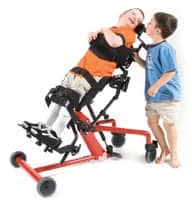 |
| EasyStand Bantam |
Altimate Medical Inc
262 W 1st St/PO Box 180
Morton, MN 56270
Phone: (800) 342-8968
Web site: www.easystand.com
Product: The EasyStand Bantam is the new pediatric stander by Altimate Medical. By integrating a supine option into the sit-to-stand stander, children have more positioning options. The Bantam is available in two different seating systems: standard planar seating or optional comfy-style seating. It comes in two sizes, extra small for kids 28 inches to 40 inches tall and small for kids 36 inches to 54 inches tall. The Bantam has a supportive Shadow Tray that follows the child from sitting to standing, and a hand-operated hydraulic pump for independent standing.
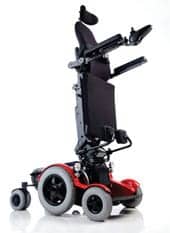 |
| power standing wheelchair C3 |
Levo USA
1705 Northland Terrace
Brooklyn Park, MN 55428
Phone: (763) 746-4425
Web site: www.levousa.com
Product: The power standing wheelchair C3 is compact, agile, and easy to handle, and transforms into four-wheel drive for active people on the move. The LEVO C3 drive system automatically adjusts from a maneuverable mid-wheel base to a gripping, climbing, four-wheel-drive action base. For classroom, work, or home, the system converts back to the tight turning radius (21.5 inches) and responsive maneuverability of the mid-wheel base.
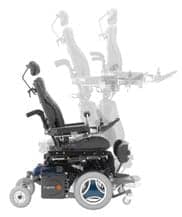 |
| C400 VS Jr |
Permobil Inc
6961 Eastgate Blvd
Lebanon, TN 37090
Phone: (800) 736-0925
Product: The C400 VS Jr incorporates standing into a child’s daily routine and allows them to drive while in a standing position. Standing can be achieved from either a sitting or a horizontal position, enabling the child to move about throughout the day and remain comfortable. Designed specifically for the pediatric market, the C400 VS Jr features a front-wheel-drive base and a rugged suspension system. The small footprint combines maneuverability with advanced obstacle climbing capabilities. A modular design of the Corpus seat ensures optimal fit with room for growth.
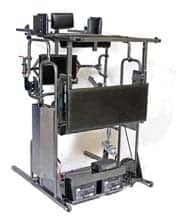 |
| Stand Aid XL |
Stand Aid of Iowa Inc
1009 2nd Ave
Sheldon, IA 51201
Phone: (800) 831-8580
Web site: www.stand-aid.com
Product: Stand Aid XL
For patients who require a stander that will lift more than 400 pounds, the Stand Aid XL bariatric power standing frame has the width and strength to accommodate users who weigh up to 550 pounds. It uses a powerful 24-volt lift system to stand users safely and comfortably directly from their wheelchair. Every XL frame is manufactured in Iowa to meet the needs of users.
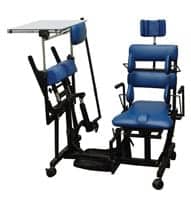 |
| Symmetry Swivel Seat |
Prime Engineering
4202 W Sierra Madre Ave
Fresno, CA 93722
Phone: (559) 276.0991
Web site: www.primeengineering.com
Product: The Symmetry Swivel Seat from Prime Engineering features better access, easier transfers, and no need to move or remove support items. Users simply pivot the seat, transfer in, swivel into place, and raise to standing.
—GT


